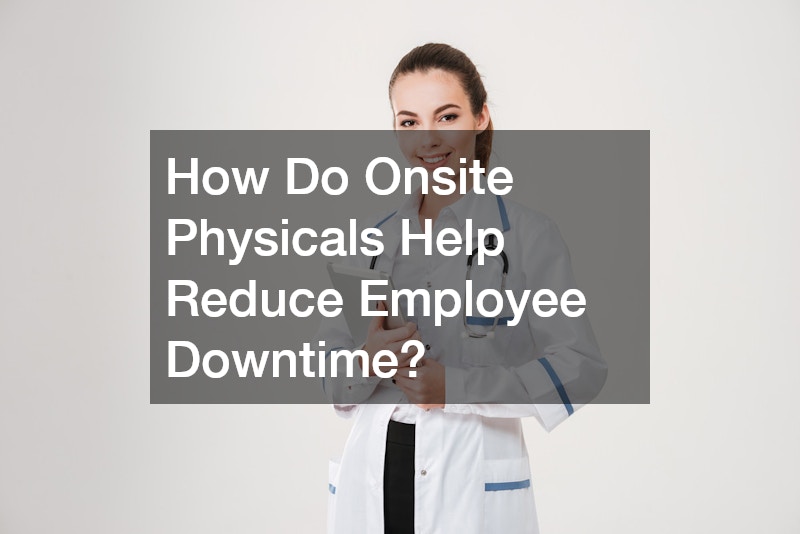Onsite physicals are becoming an increasingly popular measure for businesses looking to reduce employee downtime. These assessments, conducted at the workplace, offer several advantages over traditional medical check-ups. In this article, we will explore how onsite physicals contribute to minimizing the time employees spend away from work due to health concerns.
What are the Benefits of Onsite Physicals?
Onsite physicals provide a convenient solution by bringing healthcare to the workplace, making it easier for employees to access medical evaluations without travel or extensive planning. Employees no longer need to take time off work, as the assessments are scheduled within regular work hours, boosting participation rates.
By offering these services onsite, companies remove barriers that can prevent employees from attending regular health check-ups.
The accessibility of onsite physicals encourages employees to prioritize their health, as the process is streamlined and integrated into the workday. This proactive approach can lead to improved health outcomes over time, which ultimately benefits the employer through reduced absenteeism. Furthermore, the close proximity of these services to the workplace enhances the likelihood of employees taking advantage of them regularly.
Additionally, the convenience of onsite physicals helps employers maintain a healthier workforce by reducing the time and resources spent on coordinating external appointments. The availability of health services at the workplace supports a stress-free experience for employees, contributing to overall job satisfaction. In turn, satisfied employees are more likely to be engaged and productive, creating a positive cycle within the organization.
These assessments allow for the early identification of potential health concerns, helping address them before they escalate into more serious conditions that could result in downtime. Regular health evaluations improve the chances of detecting conditions such as hypertension, diabetes, or high cholesterol, which may not present noticeable symptoms initially. When caught early, these conditions can be managed effectively, preventing complications and preserving employees’ ability to work.
Preventative care through onsite physicals plays a crucial role in mitigating the risk of chronic conditions that can lead to prolonged absences. By identifying risks early, employees and employers can work together on developing intervention strategies, such as lifestyle changes or medication. This approach not only enhances individual health outcomes but also reduces long-term healthcare costs for the company.
How Do Onsite Physicals Impact Employee Productivity?
By ensuring that employees are in good health, onsite physicals help reduce the frequency of sickness-related absences, thereby maintaining productivity levels. Addressing minor health issues before they become significant ensures that employees can recover quickly, minimizing disruptions to the workflow. Moreover, healthier employees are less likely to spread contagious illnesses, which can lead to widespread absenteeism.
Onsite physicals also facilitate better management of chronic conditions, enabling employees to maintain their attendance and performance. When employees miss fewer days of work due to illness, they can contribute more consistently to their team’s goals and workload. The cumulative effect of reduced absenteeism makes a tangible impact on organizational efficiency and success.
The proactive approach encouraged by onsite physicals aligns with the broader objective of creating a resilient, dynamic workforce. When absenteeism drops, so does the burden on remaining employees to cover additional tasks, enhancing overall workplace harmony. By investing in such programs, companies affirm their commitment to maintaining a productive and thriving work environment.
Are Onsite Physicals a Cost-Effective Solution?
By preventing serious health issues and minimizing the need for more extensive medical care, onsite physicals can contribute to lower overall healthcare expenses for both employers and employees. Early intervention typically results in less costly treatment, and when employees stay healthier, the company can anticipate lower insurance premiums. This financial advantage strengthens the employer’s ability to invest in other employee benefits, creating a holistic support system.
Investment in preventive health measures like onsite physicals also aligns with corporate strategies aimed at minimizing unnecessary expenditures. By curtailing expenses associated with illness, such as overtime for coworkers covering shifts, businesses can allocate resources to initiatives that drive growth. The predictable healthcare expenses resulting from consistent preventative care aid in more accurate planning and budget management.
Employees also benefit financially as lower general healthcare costs result in reduced out-of-pocket expenses. When workers spend less on managing health issues, they retain more disposable income, contributing to enhanced economic stability and satisfaction. In turn, financially stable employees often exhibit increased job satisfaction and productivity, creating a positive cycle of benefits for the employer.
Incorporating onsite physicals into the workplace is an effective strategy for reducing employee downtime. They offer crucial advantages in terms of convenience, productivity, and cost-effectiveness, ultimately contributing to a healthier, more efficient workforce. As businesses continue to seek ways to maximize employee output while minimizing disruptions, onsite physicals stand out as a valuable tool in achieving these goals.




